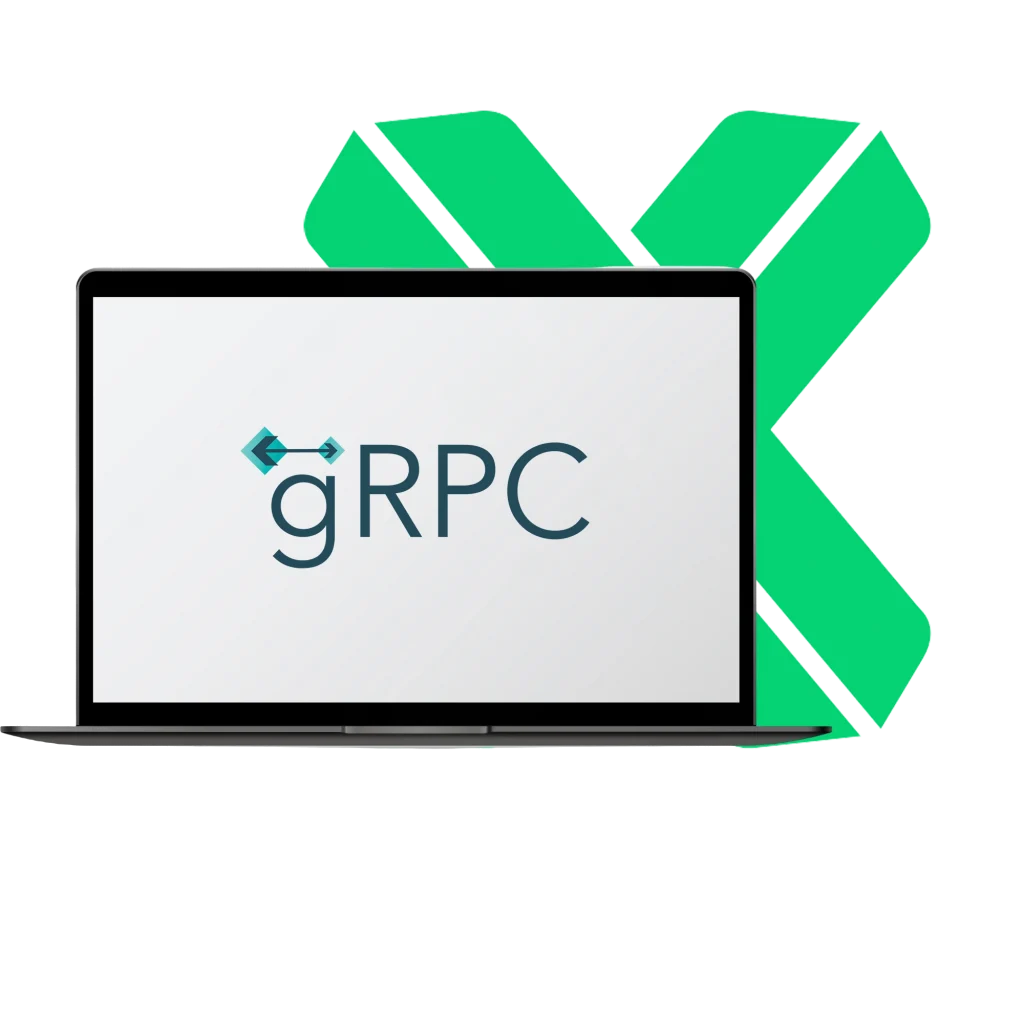GRPC DEVELOPMENT COMPANY
Build fast, efficient, and scalable APIs with gRPC and nearshore talent.
We quickly assemble skilled teams to help you build efficient microservices, APIs, and real-time applications using gRPC’s powerful framework for fast, secure, and scalable communication.

+200 companies rely on
our 1% Top Talent

gRPC Development Services We Provide
We offer comprehensive gRPC development services, from building microservices to integrating gRPC with your existing infrastructure. Explore our key offerings below:
gRPC API Development
We design and implement efficient APIs using gRPC to enable high-speed communication between services. Our team leverages Protocol Buffers (Protobuf) for defining service interfaces and message types, ensuring fast serialization and deserialization for optimal performance.
Microservices Architecture with gRPC
We build and integrate microservices architectures using gRPC, allowing services to communicate with minimal overhead. gRPC’s low-latency communication and real-time capabilities make it ideal for modern microservices-based applications.
gRPC for Real-Time Applications
Our team implements gRPC for real-time applications where speed and efficiency are critical. We develop solutions for live data streaming, chat applications, and IoT services, using gRPC’s bidirectional streaming and efficient message handling.
gRPC and RESTful API Integration
We help you transition from traditional RESTful APIs to gRPC or integrate both technologies seamlessly. By combining REST and gRPC, we ensure that your application benefits from the best of both worlds, providing flexibility for external services and high performance for internal communication.
Cross-Language Support with gRPC
We develop gRPC-based applications across multiple programming languages, enabling seamless communication between services written in different languages. gRPC’s cross-language capabilities ensure smooth interoperability between Python, Java, Go, Node.js, and other ecosystems.
gRPC Security and Optimization
Our team implements TLS encryption and advanced security measures to protect your gRPC communications. We also optimize gRPC service performance by tuning connection pooling, load balancing, and compression, ensuring low-latency, secure communication at scale.
Why Choose Xpertsoft for gRPC Development
Nearshore Expertise
Our developers are primarily based in Portugal, ensuring smooth collaboration with EU-based clients. With real-time communication and bilingual professionals, we provide efficient gRPC development and support for high-performance applications.
Broad Technical Expertise
Beyond gRPC, our team brings expertise in microservices, APIs, real-time communication, and cloud-native development. We offer end-to-end solutions to ensure your gRPC applications are scalable, secure, and optimized for performance.
Tailored Solutions for High-Performance Communication
We provide flexible gRPC development services that align with your business needs. Whether you need gRPC for real-time services, API development, or microservices architectures, we tailor our solutions to meet your performance and scalability requirements.
The gRPC Ecosystem We Used in Previous Work
Microservices and API Development
Build fast, efficient APIs and microservices using these gRPC tools:
- Protocol Buffers (for efficient serialization)
- gRPC Core (for high-performance communication)
- gRPC Gateway (for RESTful API translation)
- Load Balancers (for distributing requests across microservices)
Real-Time Data and Streaming
Leverage gRPC for real-time communication and streaming services:
- gRPC Streaming (for bidirectional data flow)
- HTTP/2 (for multiplexed streams)
- WebSockets (for real-time bidirectional communication)
- Kubernetes (for scalable, containerized microservices)
Security and Authentication
Ensure secure communication with gRPC’s built-in security features:
- TLS/SSL Encryption (for secure communication)
- OAuth 2.0 (for authentication)
- mTLS (for mutual TLS authentication)
- API Gateways (for security layers and monitoring)
Performance Monitoring and Optimization
Monitor and optimize your gRPC services with these tools:
- Prometheus (for monitoring and metrics)
- Grafana (for visualizing gRPC performance)
- Jaeger (for distributed tracing)
- Envoy Proxy (for load balancing and security)
Key Facts about gRPC Development
- Benefits of using gRPC
-
1. High-Performance Communication Protocol
gRPC enables fast, efficient communication between services by using HTTP/2 and Protocol Buffers. This results in low-latency, high-throughput communication, making gRPC ideal for microservices architectures and real-time applications.
2. Bidirectional Streaming and Real-Time Data Flow
gRPC supports bidirectional streaming, allowing for real-time data transmission between clients and servers. This feature makes gRPC a powerful tool for building applications that require live updates, such as chat platforms, IoT services, and collaborative tools.
3. Cross-Language Support and Interoperability
gRPC’s cross-language support allows services written in different programming languages to communicate seamlessly. By using Protocol Buffers, gRPC ensures that services can interact efficiently, regardless of their underlying language or platform.
- gRPC is primarily used for
-
gRPC is primarily used for building high-performance APIs, microservices, and real-time applications. It’s widely adopted in industries such as finance, e-commerce, and IoT for handling large volumes of data, low-latency communication, and complex service interactions.
- Reasons for gRPC’s popularity
-
Efficient Serialization with Protocol Buffers: gRPC uses Protocol Buffers (Protobuf) for compact, efficient serialization of messages, ensuring high performance and low bandwidth usage compared to traditional RESTful APIs.
• HTTP/2-Based Communication: gRPC leverages HTTP/2’s multiplexing and streaming features, allowing for multiple requests and responses over a single connection, reducing overhead and improving efficiency.
• Seamless API Translation: gRPC Gateway allows developers to expose gRPC services as RESTful APIs, providing compatibility with external services while retaining the high performance of gRPC for internal communication.
• Strong Community and Ecosystem: gRPC has a strong developer community and is supported by major cloud providers like Google Cloud, AWS, and Azure, making it a reliable and well-documented framework for building scalable, distributed systems.
• Security Built-In: gRPC supports TLS encryption by default, ensuring secure communication between services. It also integrates with OAuth 2.0 and mTLS for advanced security and authentication mechanisms.
• Scalability and Fault Tolerance: gRPC works well with cloud-native architectures and can be easily integrated with Kubernetes and Envoy for scaling microservices, load balancing, and improving fault tolerance.
- Useful Links
-
1. High-Performance Communication Protocol
gRPC enables fast, efficient communication between services by using HTTP/2 and Protocol Buffers. This results in low-latency, high-throughput communication, making gRPC ideal for microservices architectures and real-time applications.
2. Bidirectional Streaming and Real-Time Data Flow
gRPC supports bidirectional streaming, allowing for real-time data transmission between clients and servers. This feature makes gRPC a powerful tool for building applications that require live updates, such as chat platforms, IoT services, and collaborative tools.
3. Cross-Language Support and Interoperability
gRPC’s cross-language support allows services written in different programming languages to communicate seamlessly. By using Protocol Buffers, gRPC ensures that services can interact efficiently, regardless of their underlying language or platform.
gRPC is primarily used for building high-performance APIs, microservices, and real-time applications. It’s widely adopted in industries such as finance, e-commerce, and IoT for handling large volumes of data, low-latency communication, and complex service interactions.
Efficient Serialization with Protocol Buffers: gRPC uses Protocol Buffers (Protobuf) for compact, efficient serialization of messages, ensuring high performance and low bandwidth usage compared to traditional RESTful APIs.
• HTTP/2-Based Communication: gRPC leverages HTTP/2’s multiplexing and streaming features, allowing for multiple requests and responses over a single connection, reducing overhead and improving efficiency.
• Seamless API Translation: gRPC Gateway allows developers to expose gRPC services as RESTful APIs, providing compatibility with external services while retaining the high performance of gRPC for internal communication.
• Strong Community and Ecosystem: gRPC has a strong developer community and is supported by major cloud providers like Google Cloud, AWS, and Azure, making it a reliable and well-documented framework for building scalable, distributed systems.
• Security Built-In: gRPC supports TLS encryption by default, ensuring secure communication between services. It also integrates with OAuth 2.0 and mTLS for advanced security and authentication mechanisms.
• Scalability and Fault Tolerance: gRPC works well with cloud-native architectures and can be easily integrated with Kubernetes and Envoy for scaling microservices, load balancing, and improving fault tolerance.
Add top 1% devs to
your in-house teams
Tap into the expertise of our top 1% developers. Staff augmentation lets you boost your in-house teams with specialized experts. Expedite timelines without sacrificing output quality.
Here’s how we augment your team

STEP 1
Discovery Call
Share your requirements, budget, and necessary skill sets. We will draft a working timeline and select top developers for your team.
STEP 2
Assembling Your Team
Withindays, we’ll find suitable developers that fit your requirements. We ensure they have the right technical expertise and would be a great cultural fit for your team.
STEP 3
Onboarding and Scaling
After onboarding them, our developers will integrate with your team. Scale your engagement as needed – we’re happy to accommodate your demands.
Get an
entire Team
Looking to bring on more than just a few .NET developers? We’ll assemble a complete crew to support you. Whether it’s full-cycle front and back-end web development, QA, DevOps, UX/UI, or something else. Monitor the team’s performance and manage them as you see fit.
Here’s how you can get a dedicated team

STEP 1
Discovery Call
We’ll learn about your business, organization structure, objectives, budget, timelines, and resource requirements. Then, we can start identifying the ideal talent for you.
STEP 2
Team Assembly and Integration
Once we assemble your dedicated team, we’ll ensure a smooth transition as they integrate with your organization.
STEP 3
Project Kickoff
After onboarding, your team is at your disposal. You’ve now acquired the resources you need without the hassle and high cost that usually comes with recruitment
NAVIGATE
SIMILAR TECHNOLOGIES
